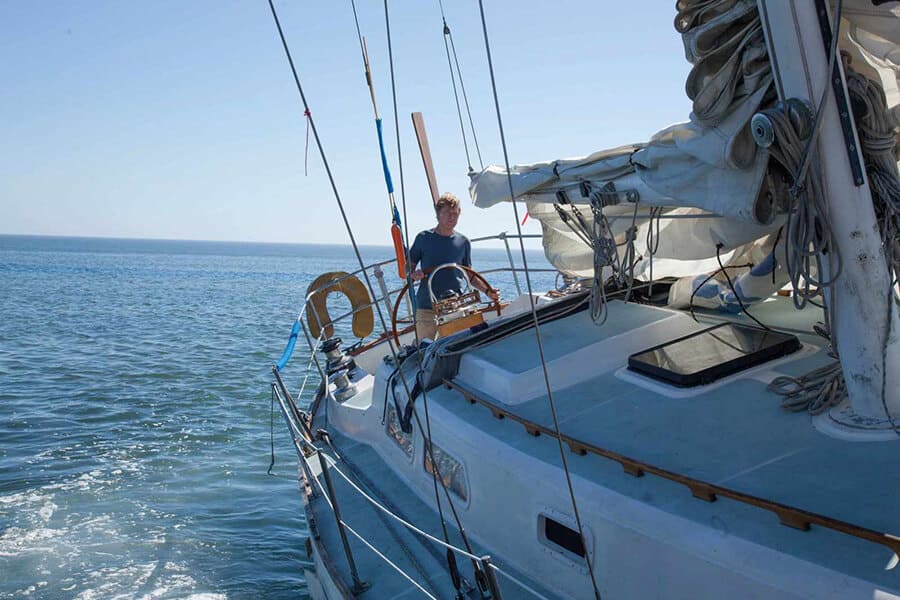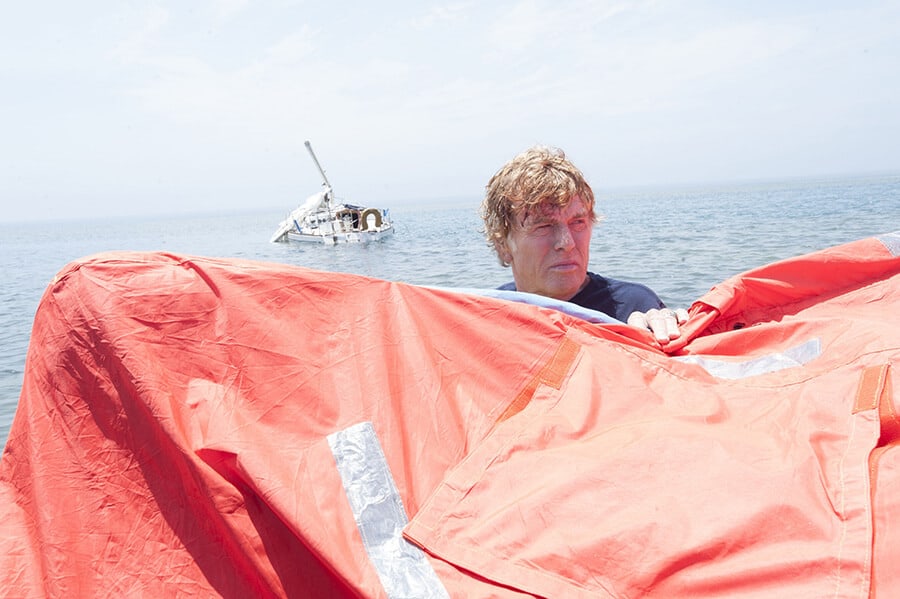“All Is Lost”, directed by J.C. Chandor, premiered at the Cannes Festival in 2013. As for actors – there was only Robert Redford, and of course the fish, and the natural entourage – the waves, the storm, and the vastness of the Indian Ocean. Nevertheless, the main character received the Golden Globe, and the film became iconic for many critics. The plot is outstanding. Even though there are but traces of dialogue in the film, episodes punctuating the story of a fearless sailor crossing the Indian Ocean on a small yacht.
Over the course of his career, Robert Redford has received the Golden Globe, an Oscar for Best Director in “Ordinary People” (starring Timothy Hutton, Mary Tyler Moore, Donald Sutherland), and BAFTA honors. But, perhaps, of all that he created or of those films where he starred, “All Is Lost” is the most powerful, driven by an invisible emotional undercurrent. Yes, not visible. The timeline forces you to revisit scenes, go back, sometimes guess about the causes and consequences. The plot moves in three dimensions, transforms itself, and creates voluminous visual content: on the one hand, we see the sailor, on the other hand, there is a “semantic” pillow for what is happening, and finally there are the thoughts and the emotions with which we respond to what we see. Although what we see has no dialogue and leaves an immeasurable space to think over.
What’s in the Plot?
The film opens with a voice-over letter. I think that it’s addressed to children or loved ones who are far away. As the story unfolds, we realize that protagonist is alone, crossing the Indian Ocean. His yacht collides with a shipping container loaded with shoes. A trade route passes nearby, and many ships sail the route weekly, transporting clothes and household items in huge containers. One of these containers pierces the side of the sailor’s yacht. He is awakened by the fact that the floor in his cabin is flooding with saltwater. It takes several days to repair the hole. As the work is underway, the sailor tries to contact the emergency dispatchers, but his SOS signals are not received. He is left alone with the unbridled element of the sea. Wrecks and storms, hurricanes and rain happen. In one of the storms, he loses his boat and transfers to an inflatable rescue raft. Now the raft will become his home, where he will reach the most dangerous points of his consciousness and moral exhaustion. In the end, he decides to commit suicide.
Redford, in total silence, comprehends the bitterness of parting with his yacht, the feeling of losing that which is most valuable – a symbiosis of fear and helplessness. Fear of the future, because whatever one may say, sailing on a boat is much safer than in an inflatable raft. Physical and mental exhaustion. But most likely moral exhaustion, too. After all, all attempts to overcome the water element turn out to be as nothing when chances of being saved appear on the horizon.
The second part of the film is about the struggle for life. Several times, the hero loses the chance to be rescued, as ships pass by. He lights a flare in a plastic canister, which leads to a fire and burns the inflatable raft on which our hero has been living. As a result, the passing ships do not observe him. Having lost his inflatable boat, the protagonist decides to die and jumps into the depths of the Indian Ocean. As for the finale – I will leave this question open.

What Can the Heroic Deeds of the Brave Teach Us?
We watch all these stories on TV and on laptop screens. Okay, “All Is Lost” is a re-broadcast of Ernest Hemingway’s ”The Old Man and the Sea”. But the rest of the stories from our series of reviews about extreme survival were real events. “Do Not Give Up”, is the first one we all think about. Yes, never give up, but how not to give up all crazy dreams when you are alone in the middle of the forest, in snow-covered mountains, or in the ocean? Here the reserves of our resources are reckoned and stored, but it is not clear why. Probably, in the civilized world, we live on “autopilot” most of the time, sustained by comfort and complete predictability. But in the wild, absolutely new conditions await us, where the rules are dictated roughly by nature, and sober thinking and heightened consciousness emerge.
Researchers at Columbia University have shown a direct link to stress hormones, not only adrenaline but also osteocalcin, which affect adaptation, endurance, and memory. These are the very substances that sober us up if we stray into the jungle, the impenetrable forest, or deep ocean waters. Although as recently as 2019, it was widely believed that adrenaline was the only hormone that was responsible for the instinct of self-preservation, and only thanks to a strong response from the adrenal glands could we find solutions in the most unpredictable situations. Having discovered osteocalcin, we can explain why the amazing human body can survive with damage to internal organs and even in the failure of the adrenal glands.
Should We Not Be Afraid of Death?
Worth asking. After all, if you look at the hero of the film “All Is Lost”, the only reason he could die is through environmental conditions that leave no hope for life. Long-distance swimming, hunger, hypothermia, or overheating are things none of us can influence. Likewise, in the films “Jungle” and “Into the Wild”, the heroes survived through willpower, if the conditions allowed them to. Although nature was not always friendly. After all, nobody has canceled natural selection. When we find ourselves in the wild, we begin to fight for life in the same way that animals do, or local people do, as they adapt to their environment.
A question begs to be answered: some settlements face danger every day, because they live in wild, remote areas – for example, Bolivian villages. And there are the inhabitants of great cities who conquer the “stone jungle”, with “sharks” and emotional storms. There are two types of survival – emotional and physical. Does it turn out that people always under stress? And maybe we just can’t function properly without the daily stimulation of these hormones. Well, maybe yes. But on the other hand, if a resident of a Bolivian village gets to New York or vice versa, he will have to jump-start his receptors and prepare for quick reactions. At first, he will be afraid, and panicked by every sound, and then he will take the situation under control. This is only to say that human beings are such unique creatures that they automatically throw all their strength into maintaining well-being and full functioning.
And what else can we learn – to love and appreciate ourselves? And if for this we need to conquer Everest, swim across the ocean, or bend over backwards in the canyons, then it is better to think twice: do I need to take on a risk that can lead to death? After all, not everyone is lucky. And you can reboot in other ways – go on a hike, move to a mountain monastery, walk the motorway. But even in such cases, we still want to admire the people who jumped into the abyss. So, what do we really need? Probably, that is the profound question that takes us to reboot.
P.S. I just told about the need of a conscious approach for life changes. For three days I have been tormented by the thought of where is the best place to get lost? In the forest, in the mountains, in the jungle. In summer or winter? What would you choose?
Photos: MovieStillsDB
Read more reviews here:
John Constantine: the Wings and Spears of a Parallel Universe
Support us!
All your donations will be used to pay the magazine’s journalists and to support the ongoing costs of maintaining the site.
Share this post
Interested in co-operating with us?
We are open to co-operation from writers and businesses alike. You can reach us on our email at [email protected]/[email protected] and we will get back to you as quick as we can.









